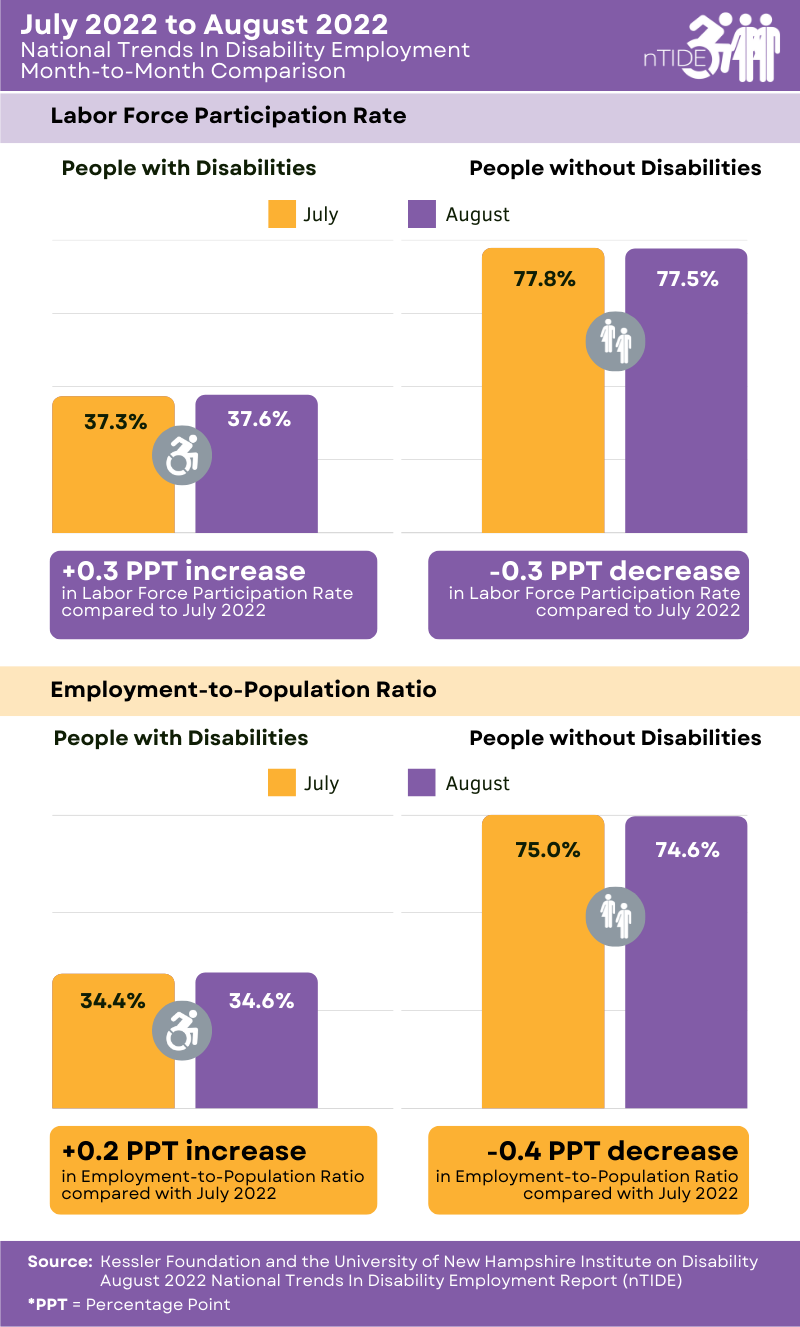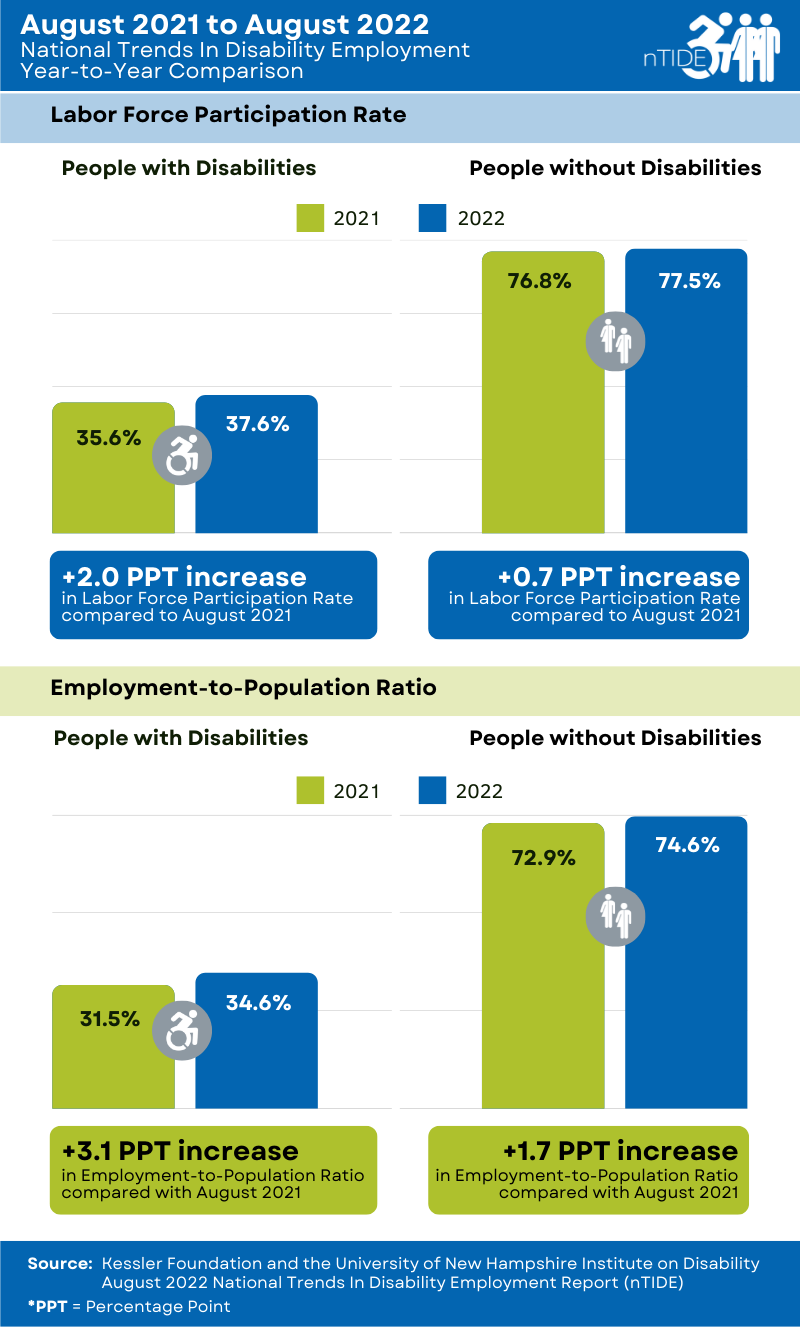National Trends in Disability Employment (nTIDE) – Issued semi-monthly by Kessler Foundation and the University of New Hampshire
East Hanover, NJ – September 2, 2022 – Despite concerns about the impact of inflation, employment indicators remained virtually unchanged, according to today’s National Trends in Disability Employment – Monthly Update (nTIDE), issued by Kessler Foundation and the University of New Hampshire’s Institute on Disability (UNH-IOD). NTIDE experts observed that this lack of movement may reflect the early impact of countermeasures aimed at slowing the pace of inflation.
Month-to-Month nTIDE Numbers (comparing July 2022 to August 2022)
In the U.S. Bureau of Labor Statistics (BLS) Jobs Report released today, the employment-to-population ratio for people with disabilities (ages 16-64) increased slightly from 34.4 percent in July to 34.6 percent in August (up 0.6 percent or 0.2 percentage points). For people without disabilities (ages 16-64), the employment-to-population ratio decreased slightly from 75.0 percent in July to 74.6 percent in August (down 0.5 percent or 0.4 percentage points). The employment-to-population ratio, a key indicator, reflects the percentage of people who are working relative to the total population (the number of people working divided by the number of people in the total population multiplied by 100).
“The employment-to-population ratio for people with disabilities has remained steadily above historic highs for the past twelve months,” said John O’Neill, PhD, director of the Center for Employment and Disability Research at Kessler Foundation. “This is encouraging for now,” he added, “considering the growing concerns about recession.”
Findings were similar for August’s labor force participation rate. For people with disabilities (ages 16-64), the labor force participation rate increased slightly from 37.3 percent in July to 37.6 percent in August (up 0.8 percent or 0.3 percentage points). For people without disabilities (ages 16-64), the labor force participation rate decreased slightly from 77.8 percent in July to 77.5 percent in August (down 0.4 percent or 0.3 percentage points). The labor force participation rate is the percentage of the population that is working, not working, and on temporary layoff, or not working and actively looking for work.

the employment-to-population ratio and labor force participation rate for people with disabilities, while these
indicators declined slightly for people without disabilities.
“The lack of movement in these labor market indicators may be an early sign of the impact of anti-inflationary measures taken by the U.S. Federal Reserve to slow the economy,” remarked Andrew Houtenville, PhD, professor of economics and the research director of the UNH-IOD. “Historically, impacts on the labor market lag behind movements in economic growth such as movement in gross domestic product (GDP). We would not expect to see large changes in employment and labor force participation until after we see declines in economic growth,” explained Dr. Houtenville.
Year-to-Year nTIDE Numbers (Comparing August 2021 to August 2022)
The employment-to-population ratio for working-age people with disabilities increased from 31.5 percent in August to 34.6 percent in August (up 9.8 percent or 3.1 percentage points). For working-age people without disabilities, the employment-to-population ratio also increased from 72.9 percent in August to 74.6 percent in August (up 2.3 percent or 1.7 percentage points).
Similarly, for people with disabilities (16-64), the labor force participation rate increased from 35.6 percent in August to 37.6 percent in August (up 5.6 percent or 2 percentage points). For people without disabilities (ages 16-64), the labor force participation rate also increased from 76.8 percent in August to 77.5 percent in August (up 0.9 percent or 0.7 percentage points).
In August, among workers ages 16-64, the 5,583,000 workers with disabilities represented 3.8 percent of the total 148,206,000 workers in the U.S.

people with and without disabilities.
Ask Questions about Disability and Employment
Each nTIDE release is followed by an nTIDE Lunch & Learn online webinar. This live broadcast, hosted via Zoom Webinar, offers attendees Q&A on the latest nTIDE findings, provides news and updates from the field, as well as invited panelists to discuss current disability-related findings and events. On September 2 at 12:00 pm Eastern, Jutta Treviranus, PhD, director, Inclusive Design Research Centre, OCAD University, Toronto, Ontario, joins Drs. Houtenville and O’Neill, and Denise Rozell, Policy Strategist at Association of University Centers on Disabilities (AUCD). Join our Lunch & Learns live or visit the nTIDE archives at: ResearchonDisability.org/nTIDE.
nTIDE COVID Update
Join us on September 23, at 12:00 pm Eastern for the mid-month COVID update – an in-depth comparison of the latest unemployment numbers for people with and without disabilities. Register at: COVID-19 Updates - 2022 | Center for Research on Disability.
NOTE: The statistics in the nTIDE are based on Bureau of Labor Statistics numbers but are not identical. They are customized by UNH to combine the statistics for men and women of working age (16 to 64). nTIDE is funded, in part, by grants from the National Institute on Disability, Independent Living and Rehabilitation Research (NIDILRR) (90RT5037) and Kessler Foundation.
The Institute on Disability (IOD) at the University of New Hampshire (UNH) was established in 1987 to provide a university-based focus for the improvement of knowledge, policies, and practices related to the lives of persons with disabilities and their families. For information on the NIDILRR-funded Research and Training Center on Disability Statistics, visit ResearchOnDisability.org.
About Kessler Foundation
Kessler Foundation, a major nonprofit organization in the field of disability, is a global leader in rehabilitation research that seeks to improve cognition, mobility, and long-term outcomes – including employment – for people with neurological disabilities caused by diseases and injuries of the brain and spinal cord. Kessler Foundation leads the nation in funding innovative programs that expand opportunities for employment for people with disabilities.